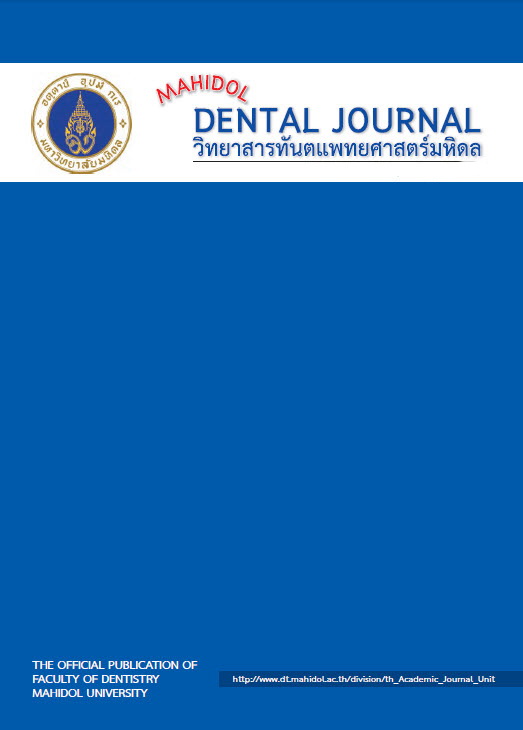Fracture resistance of four dental computer-aided design and computer-aided manufacturing glass-ceramics
Main Article Content
Abstract
Objective: The objective of this study was to compare the flexural strength of four dental computer-aided design and computer-aided manufacturing (CAD/CAM) glass-ceramics, i.e., lithium-disilicate-based (IPS e.max CAD; EMX), leucite-based (IPS Empress CAD; EMP) and two zirconia-reinforced lithium silicate glass-ceramics (CELTRA DUO; CD and VITA SUPRINITY; VS).
Materials and methods: Thirty bar-shaped specimens (1.5mm x 4mm x 18mm) were prepared for each material by cutting from rectangular blocks, and finishing their surfaces by glazing. All specimens were loaded to fracture at a crosshead speed of 0.5 mm/min using a three-point bending fixture mounted on a universal testing machine. The flexural strength values were calculated and statistically analyzed by one-way ANOVA and Dunnett T3 (α=0.05). The strength data of all groups were also analyzed using the Weibull Statistics.
Results: The result from a statistical analysis showed that VS (319±42MPa) had the highest flexural strength following by CD (278±49MPa) and then EMX (236±20MPa). EMP (157±14MPa) showed the lowest flexural strength. The Weibull moduli and the characteristic strength were 9.02 and 336.97 for VS, 6.55 and 298.87 for CD, 13.90 and 244.69 for EMX, 12.77 and 164.02 for EMP.
Conclusions: For CAD/CAM glass-ceramics examined in this study, the zirconia-reinforced lithium silicate glass-ceramics had higher flexural strength and characteristic strength than a lithium-disilicate-based and leucite-based glass-ceramics.
Article Details
References
2. Monmaturapoj N, Lawita P, Thepsuwan W. Characterisation and Properties of Lithium Disilicate Glass Ceramics in the SiO2-Li2O-K2O-Al2O3 System for Dental Applications. Adv Mater Sci Eng 2013;2013:1-11.
3. Albakry M, Guazzato M, Swain MV. Fracture toughness and hardness evaluation of three pressable all-ceramic dental materials. J Dent 2003;31:181-8.
4. Jin J, Takahashi H, Iwasaki N. Effect of test method on flexural strength of recent dental ceramics. Dent Mater J 2004;23:490-6.
5. Kang SH, Chang J, Son HH. Flexural strength and microstructure of two lithium disilicate glass ceramics for CAD/CAM restoration in the dental clinic. Restor Dent Endod 2013;38:134-40.
6. International Standard ISO 6872: Dentistry Ceramic Materials: ISO; 2015.
7. Pollington S, van Noort R. Manufacture, characterisation and properties of novel fluorcanasite glass-ceramics. J Dent 2012;40:1006-17.
8. Danzer R, Supancic P, Pascual J, Lube T. Fracture statistics of ceramics – Weibull statistics and deviations from Weibull statistics. Eng Fract Mech 2007;74:2919-32.
9. Della Bona A, Anusavice KJ, DeHoff PH. Weibull analysis and flexural strength of hot-pressed core and veneered ceramic structures. Dent Mater 2003;19:662-9.
10. Miyazaki T, Hotta Y, Kunii J, Kuriyama S, Tamaki Y. A review of dental CAD/CAM: current status and future perspectives from 20 years of experience. Dent Mater J 2009;28:44-56.
11. El-Meliegy E, Noort Rv. Glasses and Glass Ceramics for Medical Applications. 24 ed. New York: Springers; 2012. p 209-18.
12. Rinke S, Rodiger M, Ziebolz D, Schmidt AK. Fabrication of Zirconia-Reinforced Lithium Silicate Ceramic Restorations Using a Complete Digital Workflow. Case Rep Dent 2015;2015:162178.
13. Elsaka SE, Elnaghy AM. Mechanical properties of zirconia reinforced lithium silicate glass-ceramic. Dent Mater 2016;32:908-14.
14. HIRAO K, TOMOZAWA M. Dynamic Fatigue of Treated High‐Silica Glass: Explanation by Crack Tip Blunting. J Am Ceram Soc 1987;70:377-82.
15. Rashid H. The effect of surface roughness on ceramics used in dentistry: A review of literature. Eur J Dent 2014;8:571.
16. Albakry M, Guazzato M, Swain MV. Effect of sandblasting, grinding, polishing and glazing on the flexural strength of two pressable all-ceramic dental materials. J Dent 2004;32:91-9.
17. Denry I, Kelly JR. Emerging ceramic-based materials for dentistry. J Dent Res 2014;93:1235-42.
18. Albero A, Pascual A, Camps I, Grau-Benitez M. Comparative characterization of a novel cad-cam polymer-infiltrated-ceramic-network. J Clin Exp Dent 2015;7:e495-500.
19. Coldea A, Swain MV, Thiel N. In-vitro strength degradation of dental ceramics and novel PICN material by sharp indentation. J Mech Behav Biomed Mater 2013;26:34-42.
20. Vichi A, Sedda M, Del Siena F, Louca C, Ferrari M. Flexural resistance of Cerec CAD/CAM system ceramic blocks. Part 1: Chairside materials. Am J Dent 2013;26:255-9.
21. Awada A, Nathanson D. Mechanical properties of resin-ceramic CAD/CAM restorative materials. J Prosthet Dent 2015;114:587-93.


